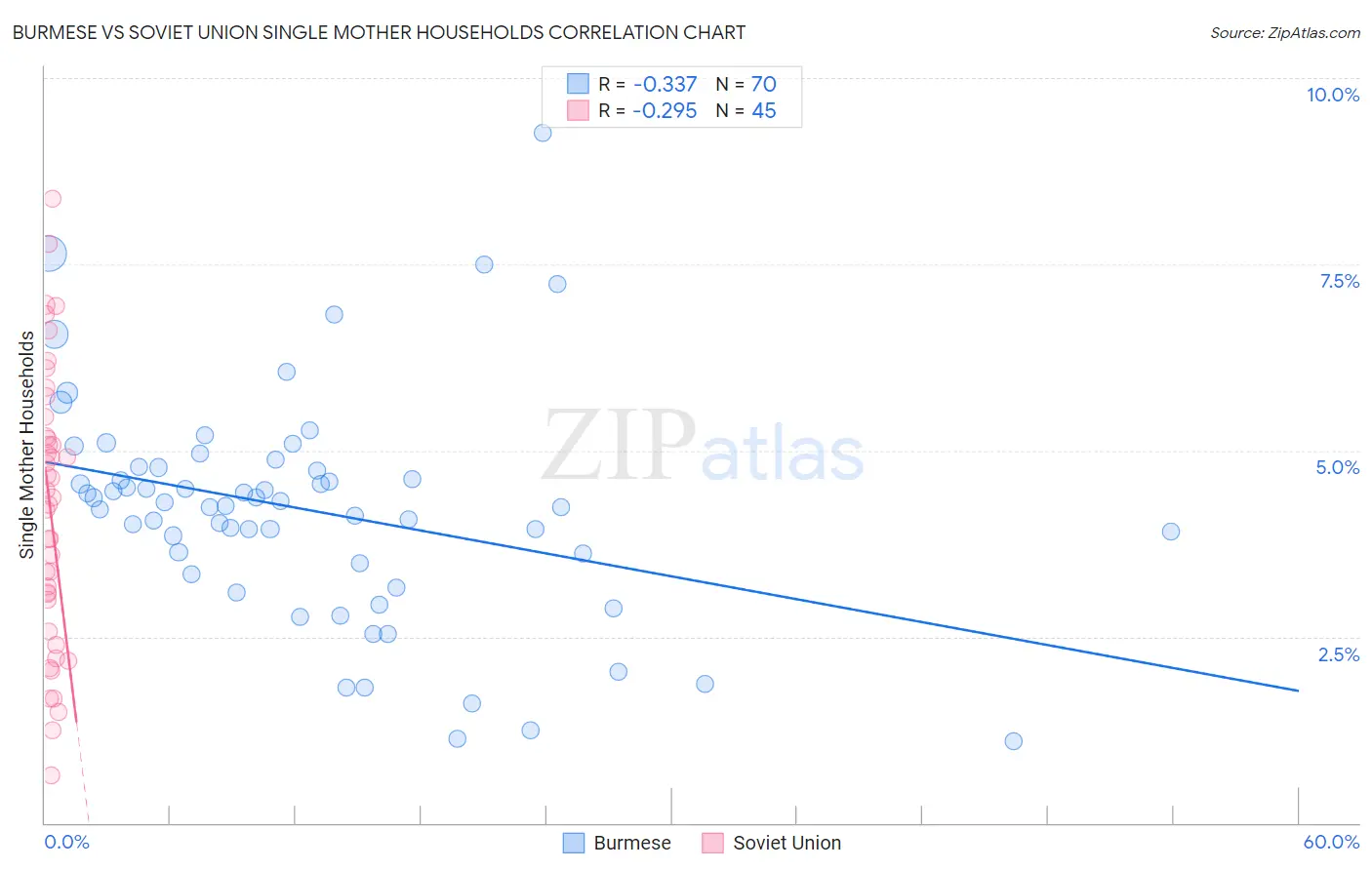Burmese vs Soviet Union Single Mother Households
COMPARE
Burmese
Soviet Union
Single Mother Households
Single Mother Households Comparison
Burmese
Soviet Union
5.3%
SINGLE MOTHER HOUSEHOLDS
99.7/ 100
METRIC RATING
30th/ 347
METRIC RANK
5.1%
SINGLE MOTHER HOUSEHOLDS
99.9/ 100
METRIC RATING
17th/ 347
METRIC RANK
Burmese vs Soviet Union Single Mother Households Correlation Chart
The statistical analysis conducted on geographies consisting of 463,476,720 people shows a mild negative correlation between the proportion of Burmese and percentage of single mother households in the United States with a correlation coefficient (R) of -0.337 and weighted average of 5.3%. Similarly, the statistical analysis conducted on geographies consisting of 43,424,989 people shows a weak negative correlation between the proportion of Soviet Union and percentage of single mother households in the United States with a correlation coefficient (R) of -0.295 and weighted average of 5.1%, a difference of 3.3%.

Single Mother Households Correlation Summary
| Measurement | Burmese | Soviet Union |
| Minimum | 1.1% | 0.63% |
| Maximum | 9.3% | 8.4% |
| Range | 8.2% | 7.7% |
| Mean | 4.2% | 4.2% |
| Median | 4.3% | 4.4% |
| Interquartile 25% (IQ1) | 3.5% | 2.8% |
| Interquartile 75% (IQ3) | 4.8% | 5.3% |
| Interquartile Range (IQR) | 1.3% | 2.5% |
| Standard Deviation (Sample) | 1.5% | 1.8% |
| Standard Deviation (Population) | 1.5% | 1.8% |
Demographics Similar to Burmese and Soviet Union by Single Mother Households
In terms of single mother households, the demographic groups most similar to Burmese are Immigrants from Korea (5.3%, a difference of 0.0%), Cambodian (5.3%, a difference of 0.010%), Latvian (5.3%, a difference of 0.060%), Russian (5.3%, a difference of 0.080%), and Bhutanese (5.3%, a difference of 0.18%). Similarly, the demographic groups most similar to Soviet Union are Indian (Asian) (5.1%, a difference of 0.21%), Immigrants from Eastern Asia (5.1%, a difference of 0.40%), Immigrants from Australia (5.1%, a difference of 0.49%), Immigrants from Armenia (5.2%, a difference of 0.78%), and Immigrants from India (5.1%, a difference of 0.81%).
| Demographics | Rating | Rank | Single Mother Households |
| Immigrants | India | 99.9 /100 | #13 | Exceptional 5.1% |
| Immigrants | Australia | 99.9 /100 | #14 | Exceptional 5.1% |
| Immigrants | Eastern Asia | 99.9 /100 | #15 | Exceptional 5.1% |
| Indians (Asian) | 99.9 /100 | #16 | Exceptional 5.1% |
| Soviet Union | 99.9 /100 | #17 | Exceptional 5.1% |
| Immigrants | Armenia | 99.9 /100 | #18 | Exceptional 5.2% |
| Chinese | 99.9 /100 | #19 | Exceptional 5.2% |
| Maltese | 99.9 /100 | #20 | Exceptional 5.2% |
| Eastern Europeans | 99.8 /100 | #21 | Exceptional 5.2% |
| Thais | 99.8 /100 | #22 | Exceptional 5.2% |
| Immigrants | Austria | 99.8 /100 | #23 | Exceptional 5.2% |
| Armenians | 99.8 /100 | #24 | Exceptional 5.2% |
| Immigrants | Japan | 99.8 /100 | #25 | Exceptional 5.2% |
| Immigrants | Lithuania | 99.8 /100 | #26 | Exceptional 5.3% |
| Bhutanese | 99.7 /100 | #27 | Exceptional 5.3% |
| Russians | 99.7 /100 | #28 | Exceptional 5.3% |
| Latvians | 99.7 /100 | #29 | Exceptional 5.3% |
| Burmese | 99.7 /100 | #30 | Exceptional 5.3% |
| Immigrants | Korea | 99.7 /100 | #31 | Exceptional 5.3% |
| Cambodians | 99.7 /100 | #32 | Exceptional 5.3% |
| Immigrants | Switzerland | 99.7 /100 | #33 | Exceptional 5.3% |